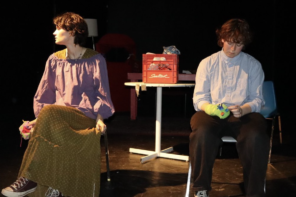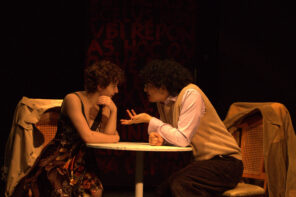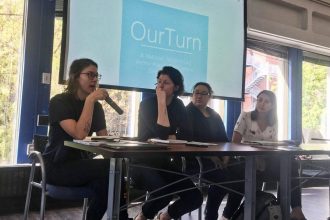An Evening with MAC’s SéminArts Program
Growing up, one of my favourite places to be was in my grandfather’s art studio. Being surrounded by the colours, the smell of oil paint drying on stretched canvas, and the haystack piles of stencils, pencils and papers became one of my favourite environments to call home. From a young age, art galleries, show openings, and the odd wine and cheese reception became staples of my weekends, and despite the stagnation of my artistic talent after mastering stick figure illustrations, my love of the arts world has continued. My early indoctrination into this world is, of course, a privileged exception. To many, it is generally assumed that in order to become a regular gallery guest, you must also have a stable RRSP plan, an asymmetrical haircut and (ideally) brightly coloured tortoise shell glasses.
The Musée d’art contemporain de Montréal has challenged these misconceptions about the art world through the SéminArts program, “an educational program [that] gives participants a chance to discover the art world and the working of the art market through five sessions with various players in the arts community, including artists, galleries, private collectors, corporate collectors and exhibition or museum curators.” I, on behalf of The Bull & Bear, was lucky enough to be invited to one of the sessions for the Winter 2018 edition. I had the privilege of speaking to its head coordinator, Véronique Lefebvre, about the introduction to contemporary art provided by SéminArts and how pluralizing the accessibility of art can only be achieved through tearing down the “snobbish” misconceptions surrounding the people that make up its community, asymmetrical haircuts and all.
The small private gallery is unusual in many ways, because unlike others of similar size, it houses full installations of extremely ambitious scale
I attended the third session of the Winter 2018 program, which was hosted by the beautiful Art Mûr gallery in Rosemont. The small private gallery is unusual in many ways, because unlike others of similar size, it houses full installations of extremely ambitious scale. The gallery has known such success it has even opened a satellite gallery in Berlin, a quantum European leap made by very few private galleries in Montreal. The evening held talks from Rhéal Olivier Lanthier and François St-Jacques, co-directors of the gallery, as well as presentations from Jannick Deslauriers and Patrick Bérubé, featured artists whose collections are on display in Art Mûr. The entire evening was dedicated to understanding the inner workings of an art gallery, and how commerce and the development of careers in the arts world meet in the same space . While every question period was lively, I was personally humbled by the realization that SéminArts functions as a foot in the door when discussing the various careers, experiences, and lives that make up Montreal’s arts community.
Demystifying and humanizing the contemporary art world is the foundation of the SéminArts program, and it is difficult to argue that they aren’t succeeding
As Véronique Lefebvre explained, “We don’t answer all the questions, that is not the point. It wouldn’t be realistic and that is not the purpose. The purpose of the SéminArts program is really to take people by the hand to the places, the artists, and the gallery owners, and show them that they are not snobbish and that these galleries actually exist and are accessible in everyone’s neighbourhoods. […] This is an introduction. When we finish an evening and we still have questions in our head, that is good. I always say to people, you need to do your homework, you cannot understand contemporary art or the art market in just a few months. Do your homework, go to your local galleries every weekend, read a bit about it. It’s funny how people are hard on contemporary art without really knowing anything about it.”
Demystifying and humanizing the contemporary art world is the foundation of the SéminArts program, and it is difficult to argue that they aren’t succeeding. Having the opportunity to meet the individuals that make up this world tackles many of the pretentious folklore that obscures it from public view. This is in large part what makes the curation of contemporary art so different. Lefebvre pointed out that what makes engagement with contemporary art so special is the opportunity to develop relationships with artists and their work as they live and continue to create in present day. During our evening at Art Mûr, both Jannick Deslauriers and Patrick Bérubé personally walked the group through their installations, speaking to the process, the physicality of the work, the desired affective response, and even indulging in self-effacing humour to acknowledge the absurdity that can pepper an artist’s day-to-day life at times. Even those who would not consider themselves connoisseurs of the visual arts would never shy away from an opportunity to ask Leonardo da Vinci what made his Mona Lisa smile, or hear Michelangelo discuss how painting the Sistine Chapel’s ceiling did his back quite a mischief. The world of contemporary art holds the possibility of these conversations and relationships with the artists, and the SéminArts program offers the invaluable service of teaching one how to navigate them whilst continuing to encourage new questions.
Registration for the Spring 2018 session starting April 18th is still open. The MAC would like to thank the generous support of the Claudine and Stephen Bronfman Family Foundation, without which this program would not be possible.









